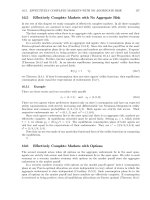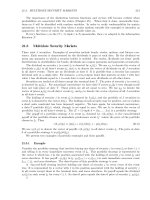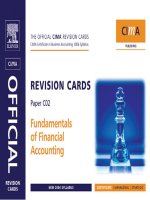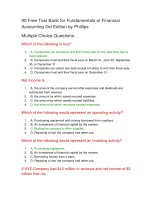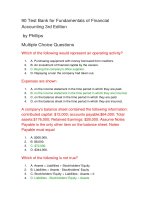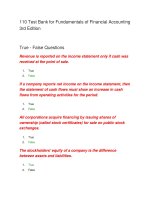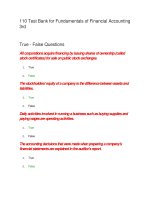CIMA BA3 fundamentals of financial accounting practice and revision kit
Bạn đang xem bản rút gọn của tài liệu. Xem và tải ngay bản đầy đủ của tài liệu tại đây (1.93 MB, 142 trang )
Certificate BA3
Fundamentals of Financial Accounting
BPP House
142-144 Uxbridge Road
London W12 8AA
United Kingdom
T 0845 075 1100 (UK)
T +44 (0)20 8740 2211 (Overseas)
E
bpp.com/learningmedia
August 2016
£17.00
For exams in 2017
Contact us
Targeted at CIMA’s computer-based
assessments, it contains:
• Objective test questions across the whole
syllabus, covering all learning outcomes
• Split by topic areas so you can target your
studies
• Detailed solutions and explanations so you
can improve your understanding with every
question you attempt
Exam Practice Kit
This Exam Practice Kit is one of a suite of
products, for use independently or as part of a
package, supporting Paper BA3 Fundamentals of
Financial Accounting. This kit helps you focus
your question practise for the assessment in a
way that makes the best use of your time.
Fundamentals of Financial Accounting
BPP Learning Media is dedicated to supporting aspiring business professionals with
top-quality learning material as they study for demanding professional exams, often
whilst working full time. BPP Learning Media’s commitment to student success
is shown by our record of quality, innovation and market leadership in paperbased and e-learning materials. BPP Learning Media’s study materials are written
by professionally qualified specialists who know from personal experience the
importance of top-quality materials for exam success.
CIMA BA3
CIMA Certificate Exam Practice Kit
CIMA Certificate
Exam Practice Kit
New
2017
Syllabus
Certificate BA3
Fundamentals of Financial Accounting
Exam Practice Kit for exams in 2017
CMCEB3(RK)AUG16 (RICOH_ASHFORD).indd 1-3
10/08/2016 09:37
CIMA Success Site
To help maximise your chances of succeeding in your exams, we’ve put together a suite of
exclusive online resources. These include access to a free digital version of this publication,
as well as extra revision resources designed to focus your efforts on your exams and study
methods.
To access the Exam Success site, please email with the subject line
“Access to Exam Success site - eBook”, including your order reference number and the name of
the book you’ve bought (ie CIMA Certificate BA2 Exam Practice Kit) for your access code. Once
you have received your code, please follow the instructions below:
To access a FREE electronic version of this material (accessible on any device and
mobile friendly), please go to:
www.bpp.com/ExamSuccessSite
n Register, first time only (replying to the confirmation email).
n Log in using your registered username and password.
Select the paper you wish to access.
n Enter the code you have received when prompted. You will only have
to do this once for each paper you are studying.
QUESTIONS
Certificate BA3
FUNDAMENTALS OF
FINANCIAL ACCOUNTING
For assessments in 2017
Exam Practice Kit
In this 2017 edition
Banks of objective test questions across the whole syllabus
Answers with detailed feedback
Advice on exam technique
First edition 2016
A note about copyright
ISBN 9781 5097 0641 9
Dear Customer
eISBN 9781 5097 0718 8
British Library Cataloguing-in-Publication Data
A catalogue record for this book is available from the British Library
Published by
BPP Learning Media Ltd
BPP House, Aldine Place
142-144 Uxbridge Road
London W12 8AA
www.bpp.com/learningmedia
Printed in the United Kingdom by Ricoh UK Limited
Unit 2
Wells Place
Merstham
RH1 3LG
Your learning materials, published by BPP Learning Media Ltd, are
printed on paper obtained from traceable sustainable sources.
All rights reserved. No part of this publication may be reproduced,
stored in a retrieval system or transmitted in any form or by any
means, electronic, mechanical, photocopying, recording or otherwise,
without the prior written permission of BPP Learning Media.
BPP Learning Media is grateful to the IASB for permission to
reproduce extracts from the International Financial Reporting
Standards including all International Accounting Standards, SIC and
IFRIC Interpretations (the Standards). The Standards together with
their accompanying documents are issued by:
The International Accounting Standards Board (IASB) 30 Cannon
Street, London, EC4M 6XH, United Kingdom. Email:
Web: www.ifrs.org
Disclaimer: The IASB, the International Financial Reporting Standards
(IFRS) Foundation, the authors and the publishers do not accept
responsibility for any loss caused by acting or refraining from acting in
reliance on the material in this publication, whether such loss is
caused by negligence or otherwise to the maximum extent permitted
by law.
©
BPP Learning Media Ltd
2016
ii
What does the little © mean and why does it matter?
Your market-leading BPP books, course materials and e-learning
materials do not write and update themselves. People write them
on their own behalf or as employees of an organisation that
invests in this activity. Copyright law protects their livelihoods. It
does so by creating rights over the use of the content.
Breach of copyright is a form of theft – as well as being a
criminal offence in some jurisdictions, it is potentially a serious
breach of professional ethics.
With current technology, things might seem a bit hazy but,
basically, without the express permission of BPP Learning Media:
Photocopying our materials is a breach of copyright
Scanning, ripcasting or conversion of our digital materials
into different file formats, uploading them to facebook or emailing them to your friends is a breach of copyright
You can, of course, sell your books, in the form in which you
have bought them – once you have finished with them. (Is this
fair to your fellow students? We update for a reason.) Please note
the e-products are sold on a single user licence basis: we do not
supply 'unlock' codes to people who have bought them
secondhand.
And what about outside the UK? BPP Learning Media strives to
make our materials available at prices students can afford by
local printing arrangements, pricing policies and partnerships
which are clearly listed on our website. A tiny minority ignore this
and indulge in criminal activity by illegally photocopying our
material or supporting organisations that do. If they act illegally
and unethically in one area, can you really trust them?
Copyright © IFRS Foundation
All rights reserved. Reproduction and use rights are strictly
limited. No part of this publication may be translated, reprinted
or reproduced or utilised in any form either in whole or in part or
by any electronic, mechanical or other means, now known or
hereafter invented, including photocopying and recording, or in
any information storage and retrieval system, without prior
permission in writing from the IFRS Foundation. Contact the
IFRS Foundation for further details.
The IFRS Foundation logo, the IASB logo, the IFRS for SMEs
logo, the “Hexagon Device”, “IFRS Foundation”, “eIFRS”, “IAS”,
“IASB”, “IFRS for SMEs”, “IASs”, “IFRS”, “IFRSs”, “International
Accounting Standards” and “International Financial Reporting
Standards”, “IFRIC” “SIC” and “IFRS Taxonomy” are Trade
Marks of the IFRS Foundation.
Further details of the Trade Marks including details of countries
where the Trade Marks are registered or applied for are available
from the Licensor on request.
Contents
Page
Using this Kit to pass your exam
Question and Answer index
Using your BPP Exam Practice Kit
The Exam
Passing the Exam
iv
v
vi
vii
Questions and answers
Questions
Answers
3
89
Introduction
iii
Question and Answer index
Page number
Question
Answer
1 The nature and objective of accounting
3
89
2 An introduction to final accounts
6
91
3 Sources, records and the books of prime entry
9
93
4 Ledger accounting and double entry
12
94
5 From trial balance to financial statements
15
95
6 Tangible non-current assets
20
97
7 Intangible non-current assets
22
98
8 Cost of goods sold and inventories
27
99
9 Irrecoverable debts and allowance for receivables
30
101
10 Accruals (and prepayments)
34
103
11 Accounting for sales tax
37
106
12 Accounting for payroll
40
108
13 Bank reconciliations
44
110
14 Control accounts
49
112
15 Correction of errors
53
114
16 Incomplete records
56
115
17 Preparation of sole traders’ accounts
59
118
18 Limited liability companies
63
120
19 Manufacturing accounts
67
121
20 Statements of cash flows
71
124
21 Interpreting company accounts
75
126
22 Preparing accounts: concepts and conventions
80
127
23 The regulatory system
83
128
Objective test questions
iv
Introduction
Using your BPP Exam Practice Kit
One of the key criteria for achieving exam success is question practice. There is generally a direct correlation
between candidates who study all topics and practise exam questions and those who are successful in their exams.
This Kit gives you ample opportunity for such practice throughout your preparations for your OT exam.
All questions in your exam are compulsory and all the component learning outcomes will be examined so you must
study the whole syllabus. Selective studying will limit the number of questions you can answer and hence reduce
your chances of passing.
Practising as many exam-style questions as possible will be the key to passing this exam. You must do questions
under timed conditions as part of your preparations.
Breadth of question coverage
Questions will cover the whole of the syllabus so you must study all the topics in the syllabus.
The weightings in the table below indicate the approximate proportion of study time you should spend on each
topic, and is related to the number of questions per syllabus area in the exam.
BA4: Fundamentals of Financial Accounting
Syllabus topics
Weighting
A Accounting Principles, Concepts and Regulations
10%
B Recording Accounting Transactions
50%
C Preparation of Accounts for Single Entities
30%
D Analysis of Financial Statements
10%
Introduction
v
The Exam
The exam is a computer based assessment, which is available on demand at assessment centres all year round.
The exams at Certificate Level can be taken in any order, but candidates must pass or be exempt from them all
before they can move on to the Operational Level.
Each exam lasts for two hours and will contain 60 questions.
The exam will be made up of different types of questions, as shown below:
vi
Question Type
Explanation
Multiple choice
Standard multiple choice items provide four options. 1 option is correct and the other 3
are incorrect. Incorrect options will be plausible, so you should expect to have to use
detailed, syllabus-specific knowledge to identify the correct answer rather than relying
on common sense.
Multiple response
A multiple response item is the same as a multiple choice question, except more than
one response is required. You will be told how many options you need to select.
Number entry
Number entry (or 'fill in the blank') questions require you to type a short numerical
response. You should carefully follow the instructions in the question in terms of how to
type your answer – eg the correct number of decimal places
Drag and drop
Drag and drop questions require you to drag a “token” onto a pre-defined area. These
tokens can be images or text. This type of question is effective at testing the order of
events, labelling a diagram or linking events to outcomes.
Hot spot
These questions require you to identify an area or location on an image by clicking on it.
This is commonly used to identify a specific point on a graph or diagram.
Item set
2-4 questions all relating to the same short scenario. Each question will be 'standalone',
such that your ability to answer subsequent questions in the set does not rely on getting
the first one correct.
Introduction
Passing the Exam
Read, and re-read the question to ensure you fully understand what is being asked.
When starting to read a question, especially one with a lengthy scenario, read the requirement first. You
will then find yourself considering the requirement as you read the data in the scenario, helping you to focus
on exactly what you have to do.
Do not spend too much time on one question – remember you should spend 2 minutes, on average, per
question.
If you cannot decide between two answers – look carefully and decide whether for one of the options you are
making an unnecessary assumption – do not be afraid of trusting your gut instinct.
Do not keep changing your mind – research has shown that the 1st answer that appeals to you is often the
correct one.
Remember that marks are awarded for correct answers, and marks will not be deducted for incorrect
answers. Therefore answer every single question, even ones you are unsure of.
Always submit an answer for a given question even if you do not know the answer - never leave any
answers blank.
Pace yourself – you will need to work through the exam at the right speed. Too fast and your accuracy may
suffer, too slow and you may run out of time. Use this Kit to practise your time keeping and approach to
answering each question.
If you are unsure about anything, remember to ask the test administrator before the test begins.
Remember to keep moving on! You may be presented with a question which you simply cannot answer due
to difficulty or if the wording is too vague. If you find yourself spending five minutes determining the answer
for a question then your time management skills are poor and you are wasting valuable time.
If you finish the exam with time to spare, use the rest of the time to review your answers and to make sure
that you answered every question.
Introduction
vii
viii
Introduction
Questions
1
2
1 The nature and objective of accounting
1
Which THREE of the following users of financial statements are likely to be interested in the financial
statements of a small private company?
Stock market analysts
Company employees
The company's bank
Institutional shareholders
Suppliers
2
According to IAS 1 Presentation of Financial Statements which TWO of the following are objectives of
financial statements?
To show the results of management’s stewardship of the resources entrusted to it
To provide a basis for valuing the entity
To provide information about the financial position, financial performance and cash flows of an entity
that is useful to a wide range of users in making economic decisions
To facilitate comparison of financial performance between entities operating in different industries
To assist management and those charged with governance in making timely economic decisions
about deployment of the entity’s resources
3
What does GAAP stand for?
A
B
C
D
4
Generally Agreed Accounting Policies
Generally Accepted Accounting Policies
Generally Agreed Accounting Practice
Generally Accepted Accounting Practice
Which TWO of the following information needs apply to the government and its agencies in relation to the
business of a sole trader?
The government and its agencies need information to:
Establish levels of tax revenue
Assess whether the business will continue in existence
Produce national statistics
Assess the owner's stewardship
Take decisions about their investment
Questions
3
5
In the UK which of the following are responsible for the preparation of company annual financial
statements?
A
B
C
D
6
The shareholders
The board of directors
The auditors
The members
It has been suggested that there are seven separate user groups of published accounting statements. These
include owner/investors, loan payables, analysts/advisors, business contacts (for example, customers and
suppliers) and the public. Which two are missing?
1
2
7
How has the increasing complexity of modern business contributed to the development of accounting?
A
B
C
D
8
Lenders need more information
Government needs more information
Too many transactions, so managers need a means of summarising them
Too many transactions, so investors need a means of summarising them
Fill in the blanks.
The main distinction between financial accounting and management accounting is that financial accounting
provides ______________________ information to people _____________________ the organisation,
whereas management accounting provides __________________________ information to
_______________________ on which they can base _______________________.
9
Capital is?
A
B
C
D
10
4
The amount borrowed to set up a business
The amount owed by a business to its proprietor(s)
The value of the assets in a business
The total amount invested in a business by all the providers of capital
Which groups of people are most likely to be interested in the financial statements of a sole trader?
1
2
3
4
Shareholders of the company
The business bank manager
The tax authorities
Financial analysts
A
B
C
D
1 and 2 only
2 and 3 only
2, 3 and 4 only
1, 2 and 3 only
Questions
11
12
Which of the following statements is/are true?
1
The shareholder needs a statement of financial prospects, ie an indication of future progress.
However, the supplier of goods on credit needs a statement of financial position, ie an indication
of the current state of affairs.
2
The objective of financial statements is to provide information about the financial position,
performance and changes in financial position of an entity that is useful to a wide range of users
in making economic decisions.
A
B
C
D
1 only
2 only
Both 1 and 2
Neither 1 or 2
The purpose of the financial statement that lists an entity's total assets and total capital/liabilities is to
show:
A
B
C
D
The financial performance of the entity over a period of time
The amount the entity could be sold for in the event of a liquidation
The amount the entity could be sold for as a going concern
The financial position of the entity at a particular moment in time
The following data relates to questions 13 to 15.
You are a trainee accountant at HTX Co, a start up company. Your boss, the managing director, has left you with
some tasks to perform.
Firstly, he wants to hire both a management accountant and a financial accountant, and has asked you to prepare a
job description for each role, based on his handwritten notes. However, he forgot to specify which of the following
duties are for which role:
Prepares accounts for internal use
Prepares accounts for external use
Prepares budgets
Compares actual performance with budget
Costs products
Prepares accounts under IFRS
Prepares the statement of financial position and statement of profit of loss
Prepares historic accounts
He has also given you the following details of transactions for the month of April 20X1.
Sales
Invoice/transaction date
01.04.16
04.04.16
01.05.16
Inv No.
001
002
003
$
2,000
3,000
1,500
Questions
5
Purchases
Invoice/transaction date
05.04.16
10.04.16
13
Inv No.
X123
000999
$
950
3,500
Select which of the duties listed above are typically part of the role of a management accountant.
Prepares accounts for internal use
Prepares accounts for external use
Prepares budgets
Compares actual performance with budget
Costs products
Prepares accounts under IFRS
Prepares the statement of financial position and statement of profit of loss
Prepares historic accounts
14
Select which of the duties listed above are typically part of the role of a financial accountant.
Prepares accounts for internal use
Prepares accounts for external use
Prepares budgets
Compares actual performance with budget
Costs products
Prepares accounts under IFRS
Prepares the statement of financial position and statement of profit of loss
Prepares historic accounts
15
What was the profit for HTX Co for April under the accruals basis of accounting?
$
2 An introduction to final accounts
1
A sole trader borrows $10,000 from a bank.
Which elements of the accounting equation will change due to this transaction?
A
B
C
D
6
Questions
Assets and liabilities
Assets and capital
Capital and liabilities
Assets only
2
A sole trader sells goods for cash for $500 which had cost $300.
Which elements of the accounting equation will change due to this transaction?
A
B
C
D
3
Assets and liabilities
Assets and capital
Capital and liabilities
Assets only
A sole trader increases the number of company motor vehicles by adding his own car to its fleet.
Which elements of the accounting equation will change due to this transaction?
A
B
C
D
4
Assets only
Capital only
Assets and capital
Assets and liabilities
The profit made by a business in 20X7 was $35,400. The proprietor injected new capital of $10,200 during
the year and withdrew a monthly salary of $500.
If net assets at the end of 20X7 were $95,100, what was the proprietor's capital at the beginning of the year?
A
B
C
D
5
Which one of the following can the accounting equation be rewritten as?
A
B
C
D
6
$50,000
$55,500
$63,900
$134,700
Assets + profit – drawings – liabilities = closing capital
Assets – liabilities – drawings = opening capital + profit
Assets – liabilities – opening capital + drawings = profit
Assets – profit – drawings = closing capital – liabilities
A business had net assets at 1 January and 31 December 20X9 of $75,600 and $73,800 respectively. During
the year, the proprietor introduced additional capital of $17,700 and withdrew cash and goods to the value of
$16,300.
What was the profit or loss made by the business in 20X9?
A
B
C
D
7
$3,200 loss
$3,200 profit
$400 loss
$400 profit
The accounting equation can be written as:
A
B
C
D
Assets + profits – drawings – liabilities = closing capital
Assets – liabilities – drawings = opening capital + profit
Assets – liabilities – opening capital + drawings = profit
Opening capital + profit – drawings – liabilities = assets
Questions
7
8
The capital of a sole trader would change as a result of:
A
B
C
D
9
Which one of the following can the accounting equation can be rewritten as?
A
B
C
D
10
A credit customer paying by cheque
Raw materials being purchased on credit
Non-current assets being purchased on credit
Personal petrol being paid for out of company petty cash
Assets
Assets
Assets
Assets
+ profit – drawings – liabilities = closing capital
– liabilities – drawings = opening capital + profit
– liabilities – opening capital + drawings = profit
– profit – drawings = closing capital – liabilities
The profit earned by a business in 20X7 was $72,500. The proprietor injected new capital of $8,000
during the year and withdrew goods for his private use which had cost $2,200.
If net assets at the beginning of 20X7 were $101,700, what were the closing net assets?
A
B
C
D
11
$35,000
$39,400
$168,400
$180,000
A sole trader is $5,000 overdrawn at her bank and receives $1,000 from a credit customer in respect of
its account.
Which elements of the accounting equation will change due to this transaction?
A
B
C
D
12
Assets and liabilities only
Liabilities only
Assets only
Assets, liabilities and capital
A sole trader purchases goods on credit.
Which elements of the accounting equation will change due to this transaction?
A
B
C
D
8
Questions
Assets and liabilities
Assets and capital
Capital and liabilities
Assets only
The following data relates to questions 13 to 15.
You are a trainee accountant at Mongoose Co. You are going through the purchase invoices for the month of April
20X1 to determine if any purchases need to be classified as capital expenditure.
You have identified the items that you think might be capital expenditure:
Purchase of a 3D printer
Repairing a broken window
Extension of the office building
Purchase of computer hardware
Purchase of ink for printers
All of the above items were purchased on credit and have not been paid for at the end of the month.
13
Which of the items should items should be classified as capital expenditure?
14
In which of the following categories of the statement of financial position should the capital expenditure
items above be included?
A
B
C
D
15
Current assets
Non-current assets
Capital
Retained earnings
What other ledger account will be affected by the capital expenditure purchases in April 20X1?
A
B
C
D
Trade receivables
Trade payables
Bank
Revenue
3 Sources, records and the books of prime entry
1
Which of the following best explains the imprest system of petty cash?
A
B
C
D
2
Each month an equal amount of cash is transferred into petty cash
The exact amount of petty cash expenditure is reimbursed at intervals to maintain a fixed float
Petty cash must be kept under lock and key
The petty cash total must never fall below the imprest amount
Which of the following is a book of original entry?
A
B
C
D
Nominal ledger
Journal
Receivables ledger
Asset register
Questions
9
3
When a purchase invoice is received from a supplier, which TWO of the following documents would the
invoice be checked to?
Sales order
Purchase order
Remittance advice
Goods received note
Credit note
4
In which book of original entry would discounts allowed be recorded?
A
B
C
D
5
In which book of original entry is VAT on credit sales recorded?
A
B
C
D
6
8
Debit note
Remittance advice
Purchase invoice
Credit note
Which of the following are books of prime entry?
1
2
3
4
Sales day book
Cash book
Journal
Purchase ledger
A
B
C
D
1 and 2 only
1, 2 and 3 only
1 only
All of them
In which book of prime entry will a business record debit notes in respect of goods which have been sent
back to suppliers?
A
B
C
D
10
Sales day book
Purchases day book
Cash book
Journal
Which of the following documents should accompany a return of goods to a supplier?
A
B
C
D
7
Sales day book
Purchases day book
Cash book
Journal
Questions
The cash book
The purchase returns day book
The purchase day book
The sales returns day book
9
Which of the following would be recorded in the sales day book?
A
B
C
D
10
Which prime entry record is used to record credit notes for returns outwards?
A
B
C
D
11
Sales returns day book
The journal
The cash book
The purchase returns day book
Which one of the following source documents is summarised and posted to the general ledger?
A
B
C
D
12
Discounts allowed
Sales invoices
Credit notes received
Trade discounts
Sales returns day book
Purchases day book
Cash receipts book
The purchase returns day book
Which prime entry record is used to record direct debits to pay utility bills?
A
B
C
D
Sales returns day book
The journal
The cash payments book
The purchase returns day book
The following data relates to questions 13 to 15.
You are an accounts assistant for Klemspeck Solutions, a company that sells computer equipment.
The following transactions took place on 23 January 20X1:
$
200
150
30
900
150
10
(i)
(ii)
(iii)
(iv)
(v)
(vi)
Cash sale of goods to Customers A Davis
Credit sale of goods to Customer H Tyre
Return of goods from Customer B Rudd
Payment to supplier Z Computers
Purchase invoice from supplier Z Computers
Purchase of stationary with petty cash
13
Which of the above transactions would be recorded in the purchases day book?
A
B
C
D
(vi)
(iv) (v)
(v)
(iv) (vi)
Questions
11
14
Which of the above transactions would be recorded in the sales day book?
A
B
C
D
15
(i)
(ii)
(iii)
(ii) (iii)
Which of the above transactions would be recorded in the cash book?
A
B
C
D
(iv)
(iv) (vi)
(i) (iv) (vi)
(iii) (iv) (vi)
4 Ledger accounting and double entry
1
2
A credit balance in a ledger account would normally be shown where the account is:
(i)
(ii)
(iii)
(iv)
(v)
An asset account
A liability account
A capital account
An income account
An expense account
A
B
C
D
(ii) and (iv) only
(i), (iii) and (v) only
(ii), (iii) and (iv) only
(ii), (iii) and (v) only
A debit entry to the sales account could represent:
A
B
C
D
3
The correction of an error or goods returned
Irrecoverable debts written off
Credit sales
Cash sales
This question examines your use of debits and credits in relation to accounts in the nominal ledger.
Ignoring the other side of an entry, which THREE of the following are true?
Incurring an expense results in a debit to the expense account.
Decrease in a liability results in a debit to the liability account.
Increase in an asset results in a credit to the asset account.
Decrease in an asset results in a debit to the asset account.
Increase in a liability results in a credit to the liability account.
12
Questions
4
An accountant has inserted all the relevant figures into the trade payables account, but has not yet balanced
off the account.
TRADE PAYABLES ACCOUNT
Cash at bank
$
100,750
Balance b/d
Purchases
$
250,225
325,010
Assuming there are no other entries to be made, other than to balance off the account, what is the closing
balance on the trade payables account?
A
B
C
D
5
How is the total of the purchases day book posted to the nominal ledger?
A
B
C
D
6
A record of amounts owed to/from individual suppliers and customers
An initial record of internally generated transactions
A list of all assets and liabilities at a point in time
A collection of accounts recording all the transactions of the business
A credit would not result in which of the following?
A
B
C
D
8
Debit purchases, Credit Cash and bank
Debit payables control, Credit purchases
Debit Cash and bank, Credit purchases
Debit purchases, Credit payables control
The nominal ledger is:
A
B
C
D
7
$474,485 DR
$575,235 DR
$474,485 CR
$575,235 CR
Increase in a liability
Increase in an asset
Increase in capital
Increase in income
In double entry bookkeeping, which of the following statements is true?
A
B
C
D
Credit entries decrease expenses and increase assets.
Credit entries decrease liabilities and increase income.
Debit entries decrease income and increase assets.
Debit entries decrease expenses and increase assets.
Questions
13
9
Jones Co. has the following transactions:
1
2
Payment of $400 to J Bloggs for a cash purchase
Payment of $250 to J Doe in respect of an invoice for goods purchased last month
What are the correct ledger entries to record these transactions?
A
B
C
D
10
DR Cash and bank
CR Purchases
$650
DR Purchases
CR Cash and bank
$650
DR Purchases
DR Trade payables
CR Cash and bank
$400
$250
DR Cash and bank
CR Trade payables
CR Purchases
$650
$650
$650
$650
$250
$400
Tin Co purchases $250 worth of metal from Steel Co. Tin Co agrees to pay Steel Co. in 60 days’ time.
What is the double entry to record the purchase in Steel Co's books?
A
B
C
D
11
Debit sales $250, credit receivables $250
Debit purchases $250, credit payables $250
Debit receivables $250, credit sales $250
Debit payables $250, credit purchases $250
T Tallon had the following transactions:
(i)
(ii)
Sale of goods on credit for $150 to F Rogit
Return of goods from B Blendigg originally sold for $300 in cash to B Blendigg
What are the correct ledger entries to record these transactions?
A
B
C
D
14
Questions
DR Trade receivables
DR Sales Returns
CR Revenue
CR Cash and bank
$150
$300
DR Revenue
DR Cash and bank
CR Trade receivables
CR Sales Returns
$150
$300
DR Trade receivables
CR Revenue
CR Sales Returns
$450
DR Sales Returns
DR Revenue
CR Cash and bank
$300
$150
$150
$300
$150
$300
$150
$300
$450
12
The suppliers’ personal accounts will appear in which of the following business records?
A
B
C
D
The nominal ledger
The sales ledger
The purchase day book
The purchase ledger
The following data relates to questions 13 to 15
You are a trainee accountant at KLS Ltd and have discovered that the following items were omitted from the books
of prime entry:
Cash sale of $50
Purchase of office chairs for $1,000
Credit sales of $450
13
Prepare a journal entry to account for the cash sale omitted from the books of prime entry.
DEBIT ___________________________ $50
CREDIT ___________________________ $50
14
Prepare a journal entry to account for the purchase of office chairs omitted from the books of prime entry.
DEBIT ___________________________ $1,000
CREDIT ___________________________ $1,000
15
Prepare a journal entry to account for the credit sale omitted from the books of prime entry.
The double entry to record a credit sale is:
DEBIT ___________________________ $450
CREDIT ___________________________ $450
5 From trial balance to financial statements
1
Which of the following statements is incorrect?
A
B
C
D
2
The closing inventory balance is included in the trial balance.
If the trial balance does not balance, an error must have been made.
The opening inventory balance is included in the trial balance.
Proprietors' drawings are shown on the trial balance.
When preparing a trial balance, the clerk omits the balance of $2,000 on the receivables account. This error
means that the total of debit balances will exceed the total of credit balances by $2,000.
A
B
True
False
Questions
15
